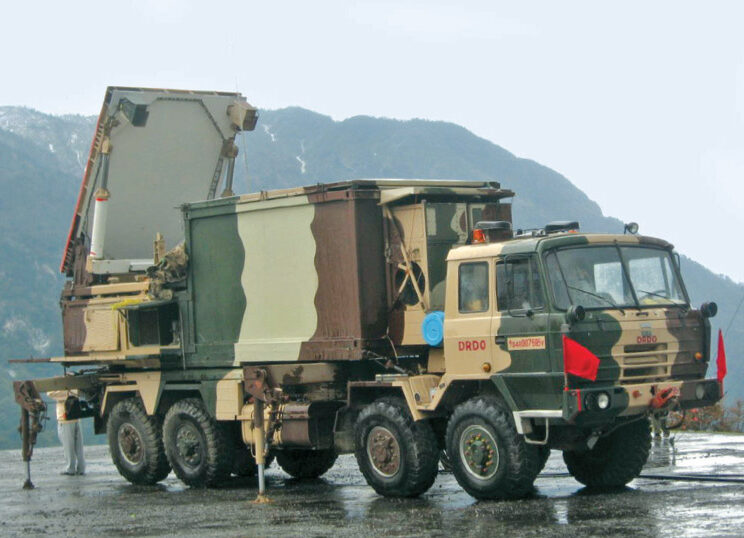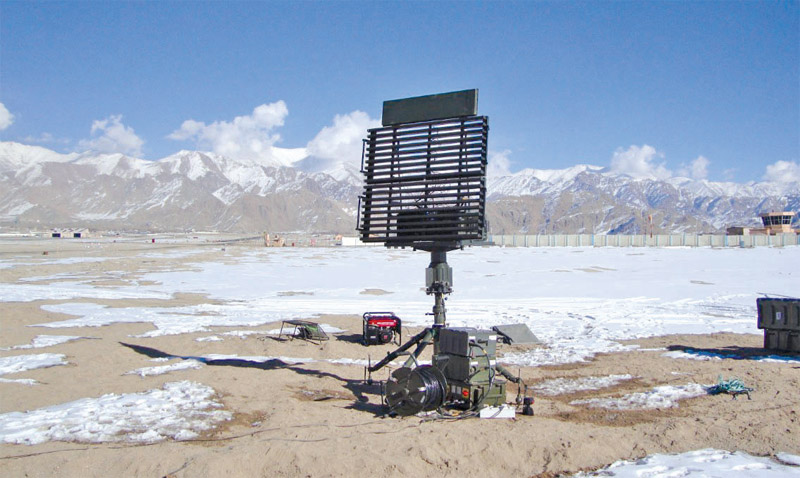Indigenously developed ground-based radars have yielded good results, but greater private sector participation needed
Atul Chandra
The Indian armed forces have large requirements for a wide range of battlefield surveillance radars and weapon locating radars. The Defence Research & Development Organisation (DRDO) has been able to successfully develop a series of radars in this category, which are now in production with state-owned defence Public Sector Undertaking (PSU), the Bharat Electronics Limited (BEL).

Today, there is a need for mobile, modular and interconnected sensor networks to provide soldiers on the battlefield with the required situational awareness. New generation advanced battlefield radars with detection ranges are lighter and more portable, require less power, and are far more maintenance friendly.
The next-generation of mobile lightweight Indian military radars will require greater participation from the Indian private sector in terms of design and development, production and life-cycle support and upgrades. Leveraging the capabilities of the Indian private sector will allow the DRDO and the BEL to focus on larger and more expensive strategic systems for the Indian armed forces.
At present, the Indian Army has a growing requirement for Low Level Light Weight Radars (LLLWR), which are mobile radars with a range of 50 km that can be transported by animal carts/trucks/helicopters for deployment in difficult terrain. The large requirement by the Indian armed and paramilitary forces for mobile lightweight radars also means that there are sufficient volumes available to make a business case for Indian private sector firms.
The Tata Advanced Systems Limited (TASL) was awarded a Buy & Make (India) contract in 2017 by the Ministry of Defence (MoD) for the supply of 31 Surface Surveillance Radars (SSR) for the Indian Navy. In March 2019, the company bagged another order from the navy for 23 ship borne 3D C/D Air Surveillance Radars (ASR) and related spares under the Buy & Make (India).
The TASL is now manufacturing a complete military radar at its Noida facility, India’s first such assembly in the private sector. It has also successfully absorbed the manufacturing Transfer of Technology (ToT) for the SSRs from Terma A/S, Denmark, its foreign technology partner, and localised majority of the parts for the radar system. The TASL is supplying these radars for coastal surveillance and will provide maintenance, long term obsolescence management to the Indian Navy for these radars.
Emerging Requirement
In December 2022, the Army Air Defence (AAD) issued a Request for Proposal (RFP) to acquire 40 units of a new Low Level Light Radar (Improved)–LLTR I–out of its authorisation of 54 such systems. The requirement for the LLTR I has arisen due to the rapid infrastructure improvements undertaken by the People’s Liberation Army (PLA) along with People’s Liberation Army Air Force (PLAAF) to enhance its capability to operate in India’s northern borders, thereby creating a need for greater low-level aerial surveillance.
The AAD is eyeing an Active Electronically Scanned Artillery (AESA) 3D radar, which can provide low level surveillance of over 50 km and provide tactical control for AAD weapons. The light weight, easily portable and technologically advanced radar system will be used for protection of vital assets in the Tactical Battle Area (TBA) in mountainous terrain and in support of mobile and mechanised operations. The LLTR I system must have weight not exceeding 175 kg (excluding the weight of power supply unit and packaging). It must be capable of being deployed at altitudes up to 5000m MSL and be able to be mounted on vehicles for operation with mechanised/mobile formation.
The Army has not opted for the DRDO developed Aslesha Mk1 LLLWR, which is in service with the Indian Air Force (IAF). The S-Band, 3D, light weight, battery powered radar provides detection and tracking of all kinds of hostile aerial targets like fighter aircrafts, UAVs and helicopters. The Aslesha LLWR has been designed for deployment in diverse terrains like plains, deserts, mountain tops and high altitude regions. It can be easily transported by men, light vehicles and slung under a helicopter and is fast and easy to install and decamp. It can track while scanning up to 100 targets and has full 3D capability using multibeam technology and is enabled for networking with an Integrated Asterix protocol. It can detect targets from 30 m to 4,500 m (AGL).
The Aslesha Mk1 radar was developed based on a 2004 Indian Air Force (IAF) requirement for 36 LLLWRs. The development of the radar commenced in December 2004 and a production contract was concluded with the BEL in March 2012 for the supply of 21 Aslesha radars from June 2013 onwards.
Battlefield Surveillance
Another success when it comes to light-weight portable radars in the Indian context is the Battlefield Surveillance Radar-Short Range (BFSR-SR) developed by the DRDO. Over 1,100 of these lightweight, man-portable battery-powered surveillance radars are thought to be in service.
The BFSR-SR is capable of searching a specified sector and track by scanning for multiple targets and can detect, track and aid in the classification of moving targets. The entire radar system can be carried by two soldiers and operated on a tripod. The compact BFSR-SR weighs about 27 kg (packed in two modules; each weighing not more than 15 kg) and can be set-up within six minutes. Foreign countries have also placed orders for the BFSR. As part of a modernisation effort undertaken in 2019, the existing control and display unit (CDU) was replaced by 15-inch military notebooks from Logic Instrument.
A newer variant is the Battlefield Surveillance Radar–Extended Range (BFSR-XR). The J-band Pulse Doppler radar is man-portable and battery powered and is capable of automatically detecting and displaying a range of moving targets such as pedestrians, group of men, vehicles, tanks, etc. It can track 99 targets simultaneously. The light-weight radar has built in test equipment (BITE) and built-in digital magnetic compass for North alignment. It can be used for border surveillance, battlefield surveillance, intelligence gathering, protection of sensitive sites and prevention of infiltration and illegal migration.

Passive Radar
The BEL also has a joint venture with Thales, incorporated in August 2014 as BEL-Thales Systems Limited (BTSL). This JV is dedicated to civilian and select ground-based military radars. The IAF ordered 19 Thales GS100 Low Level Transportable Radars (LLTR) in 2009. Six were delivered directly by Thales, followed by licence assembly of the remaining 13 radars by the BEL at its Ghaziabad facility.
The BTSL has also developed a variant of the Ground Alerter 100 for the IAF which suits Indian requirements. This passive radar does not emit any electromagnetic transmission making it completely undetectable. A demonstrator set-up was made in India for evaluation of the system in 2017. It has been deployed on a French MoD site for area sanitisation since 2015. The field proven system can be used for air surveillance and site protection missions and offers instant 360 degree detection capacity with 60 degree elevation coverage. It is particularly efficient for detection of small targets moving at low altitudes and low speed and provides alerts in case of a drone/UAV intrusion in a protected area. It can be deployed in standalone mode or integrated in a wide system, fixed or transportable solution.
Weapon Locating Radar
The Swathi WLR is now being inducted in greater numbers with the Indian armed forces. In March, the MoD contracted the BEL for procuring 12 Swathi Weapon Locating Radars (WLR) (Plains) for the Indian Army at an overall cost of nearly Rs 991 crore. The induction of all 12 WLRs in the Indian Army is planned to be completed by March 2025. The BEL has earlier received orders in 2022 for six more Swathi WLRs adapted for use in mountainous regions. At present it is thought that the army has at least 30 Swathi WLRs in operation.
The Swathi WLR was jointly developed by the DRDO lab, the Electronics & Radar Development Establishment (LRDE) and BEL. It was handed over to the Indian Army in March 2017 following extensive testing, which was undertaken in 2016. The Swathi WLR has a range of 50 km and is primarily designed to locate hostile shells, mortars and rockets. In its secondary role it can track and observe the fall of a shot from its own weapons and provide corrections if required. It can detect 81mm or higher calibre mortars from ranges of 4 to 20 km, 105 mm or higher calibre shells from 6 to 30 km, and 120mm or higher calibre free flying rockets from 6 to 40 km. The radar can track seven targets simultaneously.
According to a BEL spokesperson, ‘detection, location and tracking of the requisite targets is handled by the advanced algorithms and state-of-the-art hardware. The ability to locate enemy weapons from its first round and transmit the data of the required target to the counter fire elements for retaliatory strike before the target is redeployed is the key feature of the Swathi WLR.’ The system can perform weapon location of enemy artillery and direction of own artillery fire for friendly forces.
The Swathi WLR makes use of an electronically scanned phased array radar and uses advanced signal processing techniques for detection and tracking projectiles in the presence of ground, weather clutter and other forms of interference from Electronic Warfare (EW) systems. The truck mounted radar is designed for high mobility and quick deployment and consists of radar shelter, antenna and cooling mechanisms.

